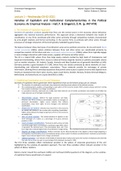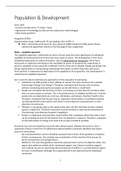Articles Author: Andreas S. Melisse
Lecture 1 – Wednesday 03-02-2021
Varieties of Capitalism and Institutional Complementarities in the Political
Economy: An Empirical Analysis – Hall, P. & Gingerich, D.W. (p. 447-474)
1. The Varieties-of-Capitalism Approach
Varieties-of-capitalism analyses assume that firms are the central actors in the economy whose behaviour
aggregates into national economic performance. This approach draws a distinction between two modes of
coordination. In one, firms coordinate with other actors primarily through competitive markets, characterized
by arms-length relations and formal contracting. In the second, firms co-ordinate with other actors through
processes of strategic interaction of the kind typically modelled by game theory.
The balance between these two types of coordination varies across political economies. At one end stand liberal
market economies (LMEs), where relations between firms and other actors are coordinated primarily by
competitive markets. At the other ends are coordinated market economies (CMEs), where firms typically engage
in more strategic interaction with trade unions, suppliers of finance and other actors.
The US is a typical LME, where firms face large equity markets marked by high levels of transparency and
dispersed shareholding, where firms’ access to external finance depends heavily on publicly assessable criteria
such as market valuation. UK, Ireland, Canada, Australia and New Zealand are all generally identified as LMEs
Germany provides a good example of a CME, where firms are closely connected by dense networks of cross-
shareholding and influential employers associations. These networks provide for exchanges of private
information, allowing firms to develop reputations that permit some access to capital on terms that depend more
heavily on reputation than share value. Austria, Japan, South Korea, Sweden, Norway, Finland, Denmark Belgium,
Netherlands and Switzerland are usually identified as CMEs.
2. Establishing Coordination as a Crucial Dimension
Varieties-of-capitalism theory generates three hypotheses that can be tested using such an analysis:
1) The character of coordination constitutes a key dimension stretching across spheres of the political economy.
2) The underlying latent variables corresponding to each sphere of the economy should reflect variation along a spectrum running
from market coordination to strategic coordination.
3) It is possible to identify a distinctive set of LMEs that make extensive use of market coordination and another set of CMEs that
make extensive use of strategic coordination.
o Shareholder power. Reflects the legal protection and likely-
influence over firms of ordinary shareholders relative to managers or
dominant shareholders. Higher scores indicate that ordinary
shareholders enjoy more rights vis-à-vis managers and dominant
shareholders.
o Dispersion of control. Indicates how many firms in the economy
are widely held relative to the number with controlling shareholders.
Higher values indicate that larger proportions of firms in the economy
are widely held.
o Size of stock market. The market valuation of equities on the
stock exchanges of a nation as a percentage of its gross domestic
product in 1993.
o Level of wage coordination. The level at which unions normally
coordinate wage-claims and employers coordinate wage-offers where
3 represents the national level, 2 the intermediate level, and 1 firm
level. High values indicate higher levels of coordination in wage setting.
o Degree of wage coordination. Reflects estimates by the OECD Secretariat of the degree to which wage bargaining is
(strategically) coordinated by unions and employers along a scale on which 3 indicates coordinated and 1 indicates uncoordinated.
Higher values indicate higher levels of wage coordination.
o Labour turnover. Is an indicator of the fluidity of national labour markets and reports the number of employees who had held
their jobs for less than one year as a percentage of all employees surveyed in 1995.
The first three variables reflect institutional variation in the sphere of corporate governance of the sort
highlighted by the varieties-of-capitalism approach. The next three variables reflect relevant variation in the
sphere of labour relations.
Nations cluster toward the southwest (LMEs) and northeast (CMEs) quadrants of the diagram, as the varieties-
of-capitalism theory would lead us to expect.
1
, Distribution Management Master Supply Chain Management
Articles Author: Andreas S. Melisse
3. Congruence Across Spheres of the Political Economy
Varieties-of-capitalism analysts argue that, where labour relations are based on high levels of job mobility and
firm-level wage-setting, training systems that provide general skills through formal education will be more
efficient than collaborative training schemes that confer industry-specific skills, because workers who must
frequently shift jobs have strong incentives to acquire the general skills that qualify them for other positions.
Conversely, where labour relations are based on strong unions and coordinated wage bargaining, it will be
efficient for firms to operate collaborative training schemes conferring high levels of industry-specific skills.
The varieties-of-capitalism literature contends that systematic variation across nations is present not only in
labour relations and corporate governance, but also across many other spheres of the political economy,
extending to relevant regulatory regimes and firm practices. For labour relations and corporate governance, we
use the same indicators employed in the preceding analysis, the others are as follows:
o Social protection. Refers to the level of support provided to the unemployed and to limitations on the right of firms to lay off
workers. Higher values indicate higher levels of social protection.
o Product market regulation. Refers to the limits placed on competition in product markets by the regulatory restrictions
that national governments impose on businesses. Higher values indicate product market regulations more restrictive of
competition.
o Training system. Are assessed with a view to establishing the extent of institutional support a nation provides for the
development of vocational skills in young workers beyond what they secure in formal secondary or university education. Higher
values indicate higher levels of institutional support for this kind of vocational training.
o Inter-firm relations. Refer to the institutionalized practices that link firms to other firms producing goods and services. Higher
values indicate more inter-firm collaboration.
o Managerial prerogative. Refers to the extent to which firms concentrate control over their operations in the hands of top
management. Higher values indicate higher levels of managerial prerogative.
o Employment tenure. Is a measure of the length of time employees typically stay with the same firm.
o Firm strategy. Is a composite measure tapping many of the core practices of firms. Higher values indicate firm strategies that
make more extensive use of ‘cooperative’ practices.
Tested the following hypothesis:
4) Institutionalized practices extending across the spheres of the political economy identified here, including those associated with
firm strategies, vary systematically such that the practices associated with market coordination are represent in multiple spheres
of political economies classified as LMEs and practices associated with strategic coordination are present in multiple spheres of
political economies classified as CMEs.
They tend to confirm the varieties-of-capitalism contention that differences based on market-oriented or
strategic coordination stretch systematically across multiple spheres of the political economy. The results: they
confirm that corporate strategies tend to vary systematically with the institutional support available for different
types of coordination in the political economy.
4. The Effect of Institutional Complementarities on Economic Growth
In the face of a fluctuating economy, firms that do not have to sustain current profitability are better placed to
make long-term commitments to their employees about wages and jobs, and therefore to realize the gains
available from deploying production regimes based on such commitments. This combination of institutions
corresponds to the institutional patterns in CMEs. Conversely, where firms are more dependent on dispersed
equity markets, face the prospect of hostile takeovers, and confront regulations that give shareholders more
power relative to stakeholders, the autonomy of the firm and its managers will be more dependent on current
profitability. This combination of institutional practices corresponds to the case of a LME. In summary terms, the
efficiencies available to firms should be higher in settings where the spheres of labour relations and corporate
governance are both dominated by the practices characteristic of either strategic or market coordination and,
according to the varieties-of-capitalism analysis, these efficiencies should show up in improved aggregate
economic performance.
The following hypothesis derived from the varieties-of-capitalism perspective on institutional complementarities
5) When there are higher levels of market (strategic) coordination in the sphere of labour relations or corporate governance, rates
of economic growth increase as the level of market (strategic) coordination in the other sphere increases.
The results tend to confirm the presence of substantial complementarities between the spheres of labour
relations and corporate governance of the sort postulated by varieties-of-capitalism theory. Two trajectories can
be made. In the first case, coordination in labour relations is held constant at its minimum value and coordination
2












